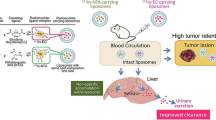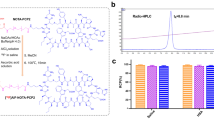Summary
New kinds of boron-containing drugs were developed and tested in several murine tumor models. The boron-containing ether lipid B-Et-11-OMe was injected in mammary carcinoma (AT17) and osteosarcoma (OTS-64) bearing mice. Furthermore boron-substituted ferrocenium derivatives were tested. Two were excessively toxic; the third could be investigated. Boron accumulation and time-dependent biodistribution were determined using alpha-particle sensitive films and inductively coupled plasma-atomic emission pectrometry (ICP-AES) and-mass spectrometry (ICP-MS) of tumors, organs and tissues. Additionally, a new method of boron detection by NMR is in preparation.
Similar content being viewed by others
References
Alberts B, Bray D, Lewis J, et al. 6. Die Plasmamembran. In: Molekularbiologie der Zelle. VCH Verlags-GmbH, Weinheim-New York, 1987, pp. 277–349.
Bartelink H, Mijnheer B, Dewit L. Is there a future for neutron capture therapy? Int J Radiat Oncol Biol Phys 1996;36:267–8.
Berdel WE, Fink U, Rastetter J. Clinical phase I pilot study of the alkyl lyso phospholipid derivate ET-18-OCH3. Lipids 1987;22:967–9.
Berdel WE. Membrane-interactive lipids as experimental anticancer drugs. Br J Cancer 1991;64:208–11.
Buchar E, Bednarova S, Gruner B, et al. Dose-dependent disposition kinetics and tissue accumulation of boron after intravenous injections of sodium mercaptoundecahydrododecaborate in rabbits. Cancer Chemother Pharmacol 1992;29:450–4.
Carlsson J, Sjöberg S, Larsson BS. Present status of boron neutron capture therapy. Acta Oncol 1992;8:803–13.
Ferrando AA, Green NR, Barnes KW, et al. Microwave digestion preparation and ICP determination of boron in human plasma. Biol. Trace Element Res 1993;37:17–25.
Flecknell P. Anaesthesia of Common Laboratory Species—Small Rodents. In: Laboratory Animal Anaesthesia. Academic Press, London 1997, pp. 160–71.
Haritz D, Gabel D, Huiskamp R. Clinical phase-I study of Na2B12H11SH (BSH) in patients with malignant glioma as precondition for boron neutron capture therapy (BNCT). Int J Radiat Oncol. Biol Phys 1994;28: 1175–81.
Hawthorne MF. The role of chemistry in the development of boron neutron capture therapy of cancer. Angew Chem Int Ed Engl 1993;32:950–84.
Jäkle F, Priermeier T, Wagner M. Novel ansa-Ferrocenes with o-Phenylene-type Bridges by B-N Adduct Formation. J Chem Soc Chem Commun 1995;1765–6.
Köpf-Maier P, Köpf H, Non-Platinum-Group Metal Antitumor Agent: History, Current Status and Perspectives. Chem Rev 1987;87:1137–52.
Köpf-Maier P, Köpf H, Neuse EW. Ferroceniumsalze—die ersten tumorhemmenden Eisenverbindungen. Angew Chemie 1984;96(6):446–7.
Komoroski RA. In vivo nmr of drugs. Analyt Chem 1994;60:1024–33.
Lemmen P, Werner B. Synthesis of rac-1-(9-o-carboranyl)nonyl-2-methyl-glycero-3-phosphocline (B-Et-11-OMe), a potential boron carrier for boron neutron capture therapy (BNCT). Chem Phys Lipids 1992;62:185–91.
Lemmen P, Weißfloch L, Auberger T, et al. Uptake and distribution of the boron-containing ether lipid B-Et-11-OMe in tumor-bearing mice. Anti-Cancer Drugs 1995;6:744–8.
Lindström P, Olsson P, Malmquist J, et al. New carborane based compounds for boron neutron capture therapy. Binding and toxicity of ANC-1, DAC-1 and B-Et-11-OMe in cultured human glioma and mouse melanoma cells. Anti-Cancer Drugs 1994;5:43–52.
Locher GL. Biological effects and therapeutic possibilities of neutrons. Amer J Roentgenol Radium Ther 1936;36:1–13.
Moore DE. A review of techniques for the analysis of boron in the development of neutron capture therapy agents. J Pharmac Biomed Analysis 1990;8:547–53.
Peller M, Weissfloch L, Weber J, et al. Oxygen induced mr-signal changes in murine tumors. Magn Res Imaging 1998 (accepted).
Pettersson OA, Grusell E, Larsson B, et al. Quantitative neutron capture radiography for boron in biological specimens. Phys Med Biol 1993;38:1089–97.
Plotzke KP, Fisher S, Wahl RL, et al. Selective localization of a radioiodinated phospholipid ether analog in human tumor xenografts. J Nucl Med. 1993;34:787–92.
Probst T, Berryman N, Lemmen P, et al. A comparison of ICP-AES and ICP-MS with quantitative neutron capture radiography for the determination of boron in biological samples from cancer therapy. J. Anal At Spectrom 1997;12:1115–22.
Slatkin DN. A history of boron neutron capture therapy of brain tumours. Postulation of a brain radiation dose tolerance limit. Brain 1991;114: 1609–29.
Snyder F, Wood R. The occurrence and metabolism of alkyl and alk-1-enyl ethers of glycerol in transplantable rat and mouse tumors. Cancer Res 1968;28:972–8.
Snyder F, Wood R. Alkyl and alk-1-enyl ethers of glycerol in lipids from normal and neoplastic human tissue. Cancer Res 1969;29:251–7.
Verrijk R, Smolders IJ, Huiskamp R, et al. Pharmacokinetics in melanoma-bearing mice of 5-dihydoxyboryl-6-propyl-2-thiouracil (BPTU), a candidate compound for boron neutron capture therapy. Br J Cancer 1994; 69:641–7.
Weissfloch L, Auberger T, Wagner FM, et al. Oxygen tensions in rodent tumors after irradiation with neutrons. Adv Exp Med Biol 1997;411: 255–60.
Woodle MC, Papahadjopoulos D. Liposome preparation and size characterization. Methods in Enzymology 1989;171:193–217.
Author information
Authors and Affiliations
Corresponding author
Rights and permissions
About this article
Cite this article
Weissfloch, L., Bremer, M., Lemmen, P. et al. New drugs for BNCT: An experimental approach. Strahlenther Onkol 175 (Suppl 2), 118–120 (1999). https://doi.org/10.1007/BF03038909
Issue Date:
DOI: https://doi.org/10.1007/BF03038909




